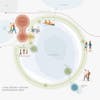Anne-Marie Pisani reflects on the AILA National Connection to Country Committee

Anne-Marie Pisani, Senior Associate and First People's Partnerships and Design Lead of ASPECT Studios in Melbourne, reflects on her time as the former Co-chair of the Australian Institute of Landscape Architects’ National Connection to Country Committee (C2CC), and how the committee’s guidance and leadership contributes to the professional growth of the Landscape Architecture profession in Australia.
It was a privilege to round out my last two years as co-chair of AILA’s National Connection to Country Committee earlier this year, together with my most supportive and considerate colleague, Nicole Croudace. Over the past few years there has been a significant increase in demand for support and guidance from the committee and the chairing role has definitely required two people to share the load. Increased interest came from AILA members and chapters seeking advice, requests for support and guidance to other AILA committees, events and festivals, through to sharing an understanding with the broader built environment professions. In addition to this, we were also committed to building a solid Connection to Country framework for the ongoing development of the committee.

In recognising the contribution that AILA’s C2CC has made to date, I proudly acknowledge the committee's development and the importance of First People’s leadership as AILA Cultural Ambassadors within the committee. In particular, I’d like to highlight the contributions of the inaugural Cultural Ambassadors. The importance of the understanding that has developed through the committee over time has more recently been identified and adopted as one of AILA’s three core values.
The relationships and deeper understandings developed between committee members and Cultural Ambassadors were and continue to be key to the successful guidance by the committee. We have handed over the co-chair role feeling energised about future opportunities to be identified and explored, based upon the solid foundation of understanding that has been built to date. The committee continues to encourage the profession towards developing relationships, which results in more meaningful and connected outcomes for both community and projects. That said, we must ensure that we continue to further understand and develop how we enable self-determination in the design process. How do the communities we work with wish to work with us?
The committee has also further developed in terms of how it operates. Nicole and I have stepped into emeritus roles within the committee. This role ensures the many years of building and fostering genuine and trusting relationships (in my case from the late 1990s at a national AILA level) to ensure that the level of understanding is not lost at the end of the role’s allocated term, but instead is able to continue to be shared and help the development of the newer members and ongoing, long-term relationships.
The understanding and approach of working with First Peoples has changed significantly over the last few years and although there are many factors involved in this change, the committee’s guidance in our profession I believe has been a significant contributing factor. Previous approaches that we now understand to be culturally inappropriate have made way for ones where there is a genuine commitment for communities to determine their rights and enable self-determination.
Serious challenges remain for the profession – we need to continue to develop so that we can increase our relevance for First Peoples in order to increase representation amongst our members. There are more First Peoples practitioners than ever before, but we can and need to do better. We also have a responsibility to understand and enact on reducing the cultural load of communities we work alongside.
There were several highlights for me during my term as co-chair. We had the opportunity to provide advocacy and input across a range of areas with the main ones being AILA’s incorporation of a Connection to Country understanding informing one of its three core values and further embedding this into the core criteria framework for the Landscape Architecture Awards. The Cultural Ambassadors provided feedback on AILA’s Climate Positive Design Action Plan and the Cultural Ambassador Guidelines were reviewed and updated. We provided a further support role on behalf of the committee at the past two AILA Festivals, where I was able to help build and guide relationships and provide advocacy on all things Connection to Country related, including the development of briefing notes for future Festival creative directors.

Highlights that were less at committee level and more at member level lay in observing a growth in members’ confidence in building relationships and understanding with First Peoples in culturally responsive ways. I can see how this is leading to greater involvement and leadership opportunities with and for First Peoples, and the richness this results in – richness in relationships, for community outcomes and as project outcomes.
Overall, I’m most proud of the way the committee of AILA members, Cultural Ambassadors, and this year for the first time First Nations Practitioners, continues to share respectful and insightful conversations that build on knowledge and understanding. These conversations are often the seeds for future guiding principles.
It has been an honour to be involved in helping to guide the national advocacy of First People’s involvement in our profession. I look forward to the committee’s continued development and success.



